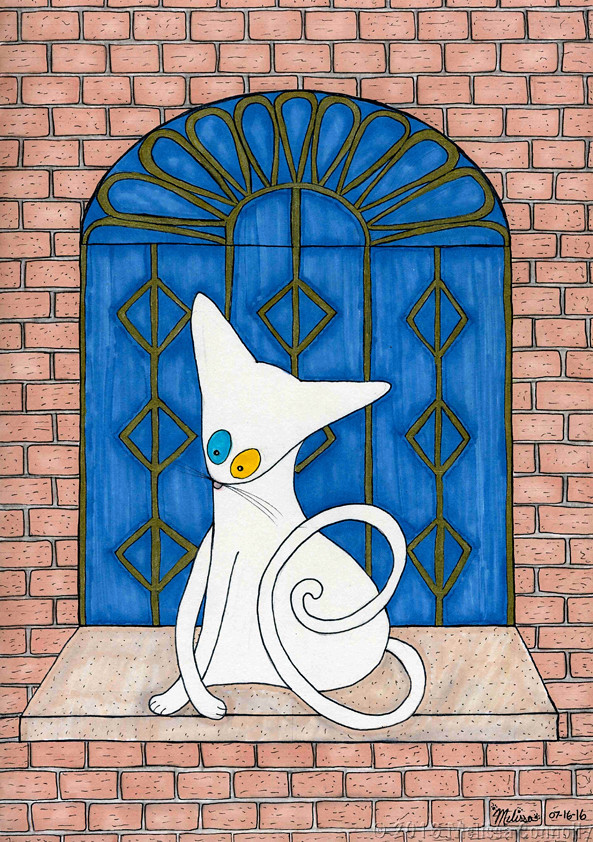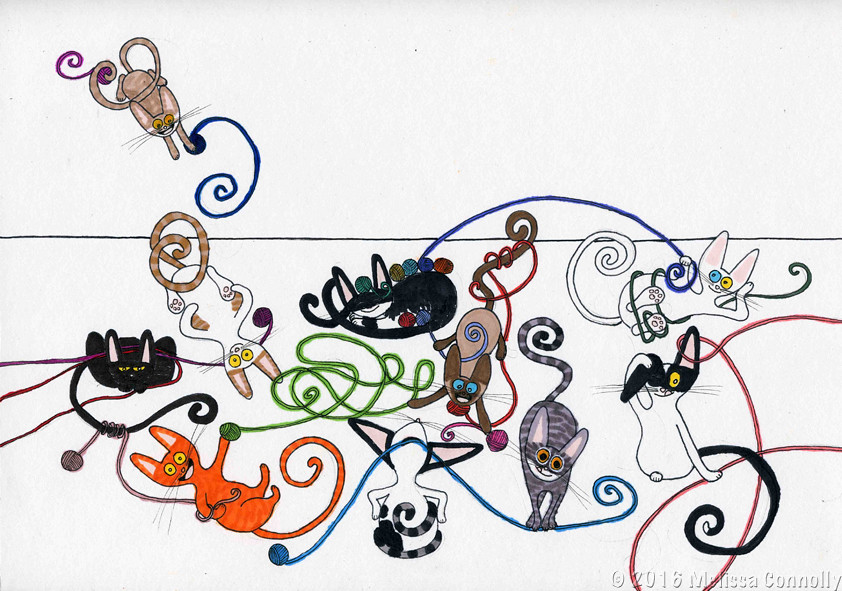 |
| (Illustration Friday: July 10, 2016) |
Wednesday, July 20, 2016
Sunday, July 17, 2016
Vintage
This drawing started as an homage to Al Hirschfeld after I watched a great documentary about him called The Line King last weekend. (Netflix has it, if you're interested.) But my cat caricature didn't cut it, so I added some Art Deco elements because I had also recently found an old A&E Biography of Carole Lombard, one of my favorite ladies from the 1930s.
In the end, this drawing really pays tribute to The Mother Kitty. When she'd had enough messing around outside, she'd jump up to the high window sill at the front of our house and stare at us. It was her subtle way of saying, "HEY! WHERE ARE YOU? LET ME IN!"
In the end, this drawing really pays tribute to The Mother Kitty. When she'd had enough messing around outside, she'd jump up to the high window sill at the front of our house and stare at us. It was her subtle way of saying, "HEY! WHERE ARE YOU? LET ME IN!"
Monday, July 11, 2016
The French Lieutenant's Woman
Hi everyone,
 Written in 1969, the story takes place in the mid-19th century in Lyme Regis, England. Walking along the coast, Charles Smithson and his fiance Ernestina Freeman encounter a mysterious woman staring toward the sea by the cliffside. Ernestina tells Charles what she's heard about her: Her name is Sarah Woodruff. She was a governess who helped nurse a wounded French lieutenant back to health. They had a an affair but he left town, and she is still waiting for his return. Ms. Woodruff has lived with a scandalous reputation ever since and relies on the charity of others who will give her a place to stay and work to do. According to Ernestina, it's best to stay away from this outcast.
Written in 1969, the story takes place in the mid-19th century in Lyme Regis, England. Walking along the coast, Charles Smithson and his fiance Ernestina Freeman encounter a mysterious woman staring toward the sea by the cliffside. Ernestina tells Charles what she's heard about her: Her name is Sarah Woodruff. She was a governess who helped nurse a wounded French lieutenant back to health. They had a an affair but he left town, and she is still waiting for his return. Ms. Woodruff has lived with a scandalous reputation ever since and relies on the charity of others who will give her a place to stay and work to do. According to Ernestina, it's best to stay away from this outcast.
This book felt long to me (probably because I sometimes took long breaks between chapters), but the writing is impressive and intricate. The lengthy descriptions, detail, and explanations all serve a purpose, catapulting readers into the era and environment with fully developed characters. I could picture and hear all of them in my head because of the way the author described their appearance, gestures, attitudes, and speaking patterns.
The peripheral characters and their stories were more interesting to me than Charles's problems. After Charles's servant Sam begins courting Ernestina's servant Mary, for example, his own ambitions and frustrations come to light as he aims for a life beyond his current status. Charles's ignorance of Sam's needs reveal the faults of his character and the class system. Similarly, Sarah deals with Mrs. Poulteney, a mean, judgmental old woman who takes her in only to build up her lacking number of good deeds.
Best,

The French Lieutenant's Woman by John Fowles is one of my dad's favorite books. He gave me a hard-cover copy once that I've been carrying around with me for years. I have tried to read it several times but typically ran out of steam by page 5 because I couldn't follow the long sentences and was too lazy to look up the words I didn't understand. This time around, I picked it from my pile – determined to push past page 5 – and I actually enjoyed this book.
 Written in 1969, the story takes place in the mid-19th century in Lyme Regis, England. Walking along the coast, Charles Smithson and his fiance Ernestina Freeman encounter a mysterious woman staring toward the sea by the cliffside. Ernestina tells Charles what she's heard about her: Her name is Sarah Woodruff. She was a governess who helped nurse a wounded French lieutenant back to health. They had a an affair but he left town, and she is still waiting for his return. Ms. Woodruff has lived with a scandalous reputation ever since and relies on the charity of others who will give her a place to stay and work to do. According to Ernestina, it's best to stay away from this outcast.
Written in 1969, the story takes place in the mid-19th century in Lyme Regis, England. Walking along the coast, Charles Smithson and his fiance Ernestina Freeman encounter a mysterious woman staring toward the sea by the cliffside. Ernestina tells Charles what she's heard about her: Her name is Sarah Woodruff. She was a governess who helped nurse a wounded French lieutenant back to health. They had a an affair but he left town, and she is still waiting for his return. Ms. Woodruff has lived with a scandalous reputation ever since and relies on the charity of others who will give her a place to stay and work to do. According to Ernestina, it's best to stay away from this outcast.
But, of course, Charles does not. Intrigued, he walks up to her, cautioning her away from the cliff's edge. This small gesture of kindness gets Sarah's attention, and eventually, she asks to meet with him in secret. She longs to share her story with someone who has an empathetic ear. As these meetings progress, their connection becomes undeniable for Charles. He becomes so obsessed with Sarah that it throws his life into full disarray, scandal, and uncertainty.
The French Lieutenant's Woman has many ambitious unique features. The author is present throughout the story. He injects his thoughts about the writing of it and its characters, describes scenes or locations, and explains points in characters' conversations. This novel has footnotes, some of which take up half of a page. It also has related excerpts from other books at the start of each chapter. The author even becomes an actual character in the story during two of the three endings he offers.
While these elements are inventive and refreshing, I found some of it hard to follow, which made me lose interest. I just wanted to get on with the story rather than learn the history of something a character casually mentions or find out the types of foliage that grows best in certain areas of town. I also didn't like having three endings from which to choose, the last of which seemed most unresolved. However, I'm sure these features are what make this book the classic, best-selling, award-winning piece of literature it is.
While these elements are inventive and refreshing, I found some of it hard to follow, which made me lose interest. I just wanted to get on with the story rather than learn the history of something a character casually mentions or find out the types of foliage that grows best in certain areas of town. I also didn't like having three endings from which to choose, the last of which seemed most unresolved. However, I'm sure these features are what make this book the classic, best-selling, award-winning piece of literature it is.
This book felt long to me (probably because I sometimes took long breaks between chapters), but the writing is impressive and intricate. The lengthy descriptions, detail, and explanations all serve a purpose, catapulting readers into the era and environment with fully developed characters. I could picture and hear all of them in my head because of the way the author described their appearance, gestures, attitudes, and speaking patterns.
The peripheral characters and their stories were more interesting to me than Charles's problems. After Charles's servant Sam begins courting Ernestina's servant Mary, for example, his own ambitions and frustrations come to light as he aims for a life beyond his current status. Charles's ignorance of Sam's needs reveal the faults of his character and the class system. Similarly, Sarah deals with Mrs. Poulteney, a mean, judgmental old woman who takes her in only to build up her lacking number of good deeds.
Finishing this book was an accomplishment, and I feel enriched by it. Since it was a struggle for me to read at times, though; I wasn't sure if I should recommend it to others....until I saw the movie version.
 I rented the 1981 Oscar-nominated film adaptation, starring Meryl Streep as Sarah and Jeremy Irons as Charles, thinking it would help clear up any lingering confusion I had. On the contrary, director Karel Reisz seemed to take a cue from John Fowles and introduced multiple story lines. In addition to playing the characters of Sarah and Charles, Meryl Streep and Jeremy Irons also played modern-day film actors and secret lovers. In this parallel story, they were adapting, researching, rehearsing, and filming The French Lieutenant's Woman, playing Sarah and Charles while their own personal relationship was similar to their characters' circumstances.
I rented the 1981 Oscar-nominated film adaptation, starring Meryl Streep as Sarah and Jeremy Irons as Charles, thinking it would help clear up any lingering confusion I had. On the contrary, director Karel Reisz seemed to take a cue from John Fowles and introduced multiple story lines. In addition to playing the characters of Sarah and Charles, Meryl Streep and Jeremy Irons also played modern-day film actors and secret lovers. In this parallel story, they were adapting, researching, rehearsing, and filming The French Lieutenant's Woman, playing Sarah and Charles while their own personal relationship was similar to their characters' circumstances.
With its unique take on this story, the film version of The French Lieutenant's Woman is good on its own terms. More than anything, though, it made me appreciate the novel – with its immersive world and colorful characters – so much more. I watched it thinking of all things the director had to gloss over and missed those details. As usual, the book is better, so give it a try (past page 5). Better yet, test them both out as I did, and let me know what you think.
 I rented the 1981 Oscar-nominated film adaptation, starring Meryl Streep as Sarah and Jeremy Irons as Charles, thinking it would help clear up any lingering confusion I had. On the contrary, director Karel Reisz seemed to take a cue from John Fowles and introduced multiple story lines. In addition to playing the characters of Sarah and Charles, Meryl Streep and Jeremy Irons also played modern-day film actors and secret lovers. In this parallel story, they were adapting, researching, rehearsing, and filming The French Lieutenant's Woman, playing Sarah and Charles while their own personal relationship was similar to their characters' circumstances.
I rented the 1981 Oscar-nominated film adaptation, starring Meryl Streep as Sarah and Jeremy Irons as Charles, thinking it would help clear up any lingering confusion I had. On the contrary, director Karel Reisz seemed to take a cue from John Fowles and introduced multiple story lines. In addition to playing the characters of Sarah and Charles, Meryl Streep and Jeremy Irons also played modern-day film actors and secret lovers. In this parallel story, they were adapting, researching, rehearsing, and filming The French Lieutenant's Woman, playing Sarah and Charles while their own personal relationship was similar to their characters' circumstances.With its unique take on this story, the film version of The French Lieutenant's Woman is good on its own terms. More than anything, though, it made me appreciate the novel – with its immersive world and colorful characters – so much more. I watched it thinking of all things the director had to gloss over and missed those details. As usual, the book is better, so give it a try (past page 5). Better yet, test them both out as I did, and let me know what you think.
Best,

Wednesday, July 06, 2016
Yarn
Subscribe to:
Posts (Atom)


